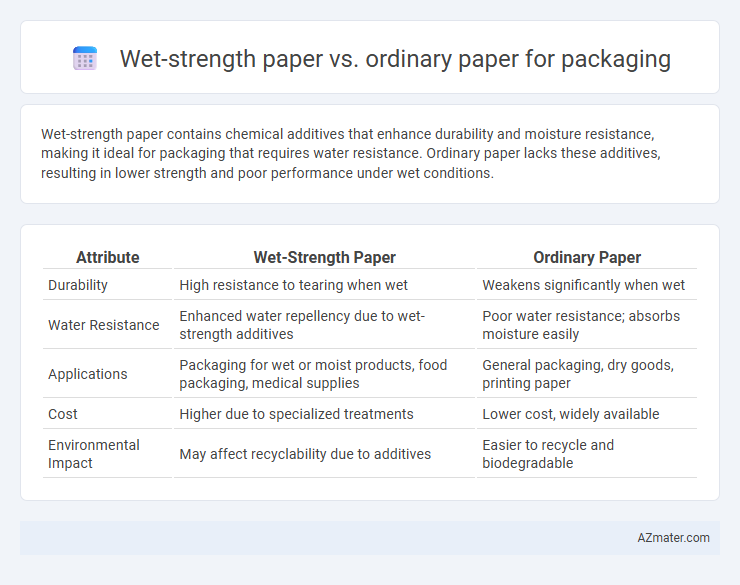Wet-strength paper contains chemical additives that enhance durability and moisture resistance, making it ideal for packaging that requires water resistance. Ordinary paper lacks these additives, resulting in lower strength and poor performance under wet conditions.
Table of Comparison
| Attribute | Wet-Strength Paper | Ordinary Paper |
|---|---|---|
| Durability | High resistance to tearing when wet | Weakens significantly when wet |
| Water Resistance | Enhanced water repellency due to wet-strength additives | Poor water resistance; absorbs moisture easily |
| Applications | Packaging for wet or moist products, food packaging, medical supplies | General packaging, dry goods, printing paper |
| Cost | Higher due to specialized treatments | Lower cost, widely available |
| Environmental Impact | May affect recyclability due to additives | Easier to recycle and biodegradable |
Introduction: Understanding Packaging Paper Types
Wet-strength paper contains additives like resins or polymers that enhance durability and resistance to moisture, making it ideal for packaging products exposed to damp conditions or requiring longer shelf life. Ordinary paper, typically made without such additives, lacks this moisture resistance and is better suited for dry, lightweight packaging needs. Selecting between wet-strength and ordinary paper depends on the packaging environment and product protection requirements.
What is Wet-Strength Paper?
Wet-strength paper is engineered with chemical additives that enhance its durability and resistance to tearing when exposed to moisture, making it ideal for packaging applications involving wet or humid conditions. Unlike ordinary paper, which weakens and disintegrates upon contact with water, wet-strength paper maintains its structural integrity, ensuring the protection and longevity of packaged goods. This specialized paper is commonly used in food packaging, industrial wraps, and labels that require reliable performance in damp environments.
Defining Ordinary Paper in Packaging
Ordinary paper in packaging refers to standard paper products that lack enhanced resistance to moisture, typically made from untreated cellulose fibers. These papers are prone to weakening and structural failure when exposed to water or high humidity, limiting their effectiveness for packaging applications requiring durability. Compared to wet-strength paper, ordinary paper offers less protection against tearing, swelling, and degradation under wet conditions, making it less suitable for products exposed to moisture.
Key Differences Between Wet-Strength and Ordinary Paper
Wet-strength paper incorporates chemical additives such as polyamide-epichlorohydrin resins that enhance resistance to water, preventing fiber breakdown and maintaining integrity when exposed to moisture. Ordinary paper lacks these additives, making it prone to weakening, tearing, and disintegration upon contact with liquids, which limits its effectiveness for packaging applications requiring durability under wet conditions. The key difference lies in wet-strength paper's enhanced bonding properties that provide superior tensile strength and durability, crucial for packaging products exposed to moisture during transport or storage.
Performance in Moisture and Humidity
Wet-strength paper outperforms ordinary paper in packaging applications by maintaining structural integrity and resistance to moisture and humidity, preventing disintegration and maintaining durability in damp environments. Ordinary paper lacks additional chemical reinforcement, causing it to weaken, tear, or deform when exposed to water or high humidity. The incorporation of wet-strength resins in wet-strength paper enhances fiber bonding, making it ideal for packaging products that require protection against moisture during transportation and storage.
Strength and Durability Comparison
Wet-strength paper contains chemical additives that enhance fiber bonding, significantly improving its resistance to water damage and maintaining structural integrity in moist conditions. Ordinary paper lacks these additives, resulting in reduced strength and rapid deterioration when exposed to moisture, making it less suitable for packaging products prone to damp environments. Consequently, wet-strength paper offers superior durability and reliability for packaging applications requiring moisture resistance and long-lasting performance.
Environmental and Sustainability Factors
Wet-strength paper for packaging offers enhanced durability and resistance to moisture, significantly reducing material waste and extending product lifespan compared to ordinary paper. Its biodegradability and recyclability align with sustainable practices, as it requires fewer chemical additives than synthetic alternatives, minimizing environmental impact. Choosing wet-strength paper supports eco-friendly packaging solutions by balancing strength needs and reducing resource consumption.
Cost Considerations for Packaging Solutions
Wet-strength paper offers enhanced durability and resistance to moisture, which reduces packaging failures and product damage, potentially lowering overall replacement and loss costs. Ordinary paper tends to be less expensive upfront but may incur higher indirect costs due to reduced performance in humid or wet conditions, leading to increased waste and customer dissatisfaction. Evaluating total cost of ownership, including durability and product protection, is essential when choosing between wet-strength and ordinary paper for packaging solutions.
Applications and Industry Use Cases
Wet-strength paper offers superior durability and moisture resistance, making it ideal for packaging products in the food, beverage, and chemical industries where exposure to liquids is common. Ordinary paper, lacking enhanced wet strength, is primarily used for packaging dry goods such as clothing, stationery, and lightweight consumer products. Industries requiring robust, moisture-resistant packaging solutions frequently choose wet-strength paper for items like frozen foods, pharmaceuticals, and industrial parts to ensure product integrity during transit and storage.
Choosing the Right Paper for Your Packaging Needs
Wet-strength paper offers superior durability and resistance to moisture, making it ideal for packaging products exposed to water or high humidity. Ordinary paper lacks this enhanced strength, which can lead to weakened packaging and compromised product protection under wet conditions. Selecting wet-strength paper ensures reliable performance for packaging applications requiring moisture resistance, while ordinary paper suits dry, low-humidity environments where cost efficiency is a priority.

Infographic: Wet-strength paper vs Ordinary paper for Packaging
 azmater.com
azmater.com